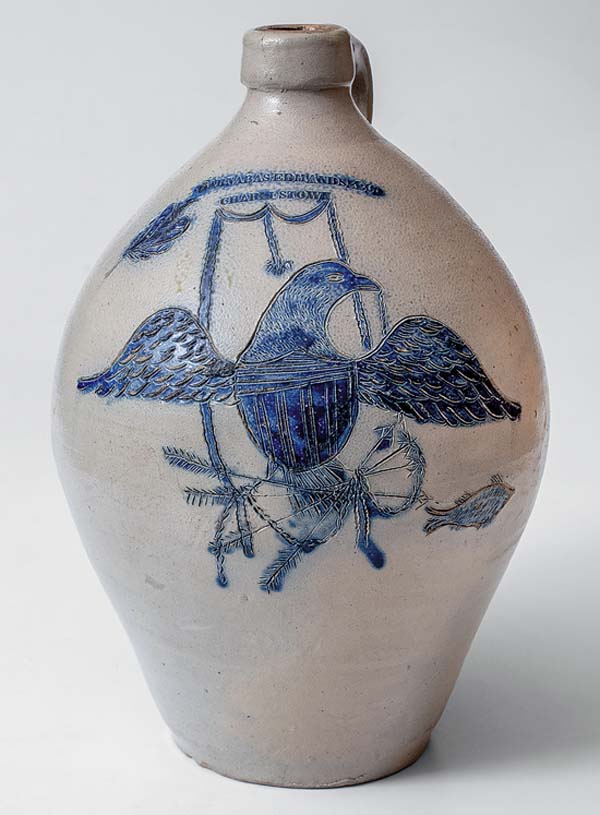A Massachusetts stoneware jug with incredibly fine incised eagle decoration sold on April 6 at Crocker Farm. The BARNABAS EDMANDS & CO. / CHARLESTOWN, ca. 1830 jug with a large incised design of a Federal eagle realized $180,000, selling to author and scholar Rob Hunter on behalf of the William C. and Susan S. Mariner Private Foundation. The Zipps considered this among the finest examples of eagle decoration on stoneware. The decoration was incredibly beautiful, and the Mariners are branching out to other great examples, not just from the South, noted Hunter. The contrast between the deep cobalt slip and light gray background, along with fine detail, created a dramatic image. Its decorative appeal and rarity of the decoration define it as one of the two finest examples of utilitarian pottery, either stoneware or redware, produced within the Boston neighborhood of Charlestown. (The other leading Charlestown product, the Elisabeth Tarbell / 1806 stoneware jar by Frederick Carpenter, was sold in Crocker Farms Spring 2021 Auction, also for $180,000). Rich in a ceramic legacy beginning with redware production in the early 18th century, Charlestown became a major manufacturer of stoneware at the turn of the 19th century with the work of Frederick Carpenter, who used a BOSTON stamp to identify his ware. In 1812, he became the master potter at the Austin Street shop of Barnabas Edmands, whose makers mark is on this piece. Edmands was not a potter, but rather a brass founder who became a pottery owner, hiring and even partnering with Carpenter until the latters death in 1827. As written in the Crocker Farm catalog, according to Lura Woodside Watkins book, Early New England Potters and Their Wares, Edmands hired out a new lead potter, Charles Collier, upon Carpenters death. Collier worked at the pottery for decades, and his abilities are evidenced by awards won in local 1839 and 1841 fairs for oversized stoneware vessels that he made, including a 15-gallon pitcher. Given his involvement with the pottery and years active, he possibly created this jug. Edmands and his descendants would be a dominant force in regional stoneware production for nearly 100 years, serving as Charlestowns sole producer of stoneware until 1905. According to Lorraine Germans Ceramics in America 2019 article, The Picture of the Old Pottery, Edmands son, Benjamin B. Edmands, would became a potter himself, working at the family concern until the Civil War, when he served as lieutenant in the 54th Massachusetts Volunteer Infantry, one of the Unions first all-black regiments, famously depicted in the Academy-award-winning movie, Glory. An attributed Edmands Pottery jar of similar age to this jug, depicting a molded Federal eagle and date of the Battle of Bunker Hill on reverse, is on display at the William C. and Susan S. Mariner Southern Ceramics Gallery at the Museum of Early Southern Decorative Arts, a further exhibition of patriotic expression in this potterys work. The Crocker Farm jug was previously owned by ceramics author and collector Georgeanna Greer and illustrated on the covers of the first and second editions of her well-known 1981 book, American Stonewares: The Art & Craft of Utilitarian Potters. It previously sold at the Harmer Rooke Galleries Auction of the Georgeanna H. Greer Collection, Nov. 18, 1992, for $17,050. To learn more, visit www.crockerfarm.com.
Antiques & Auction News is owned and published by Engle Printing & Publishing Co., Inc. and is the source for marketplace news on art and antiques.






